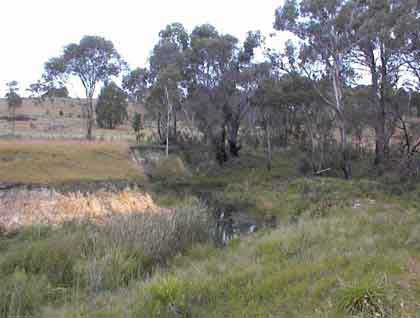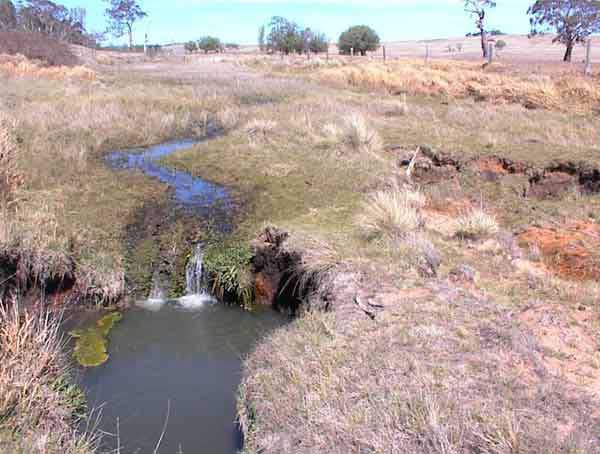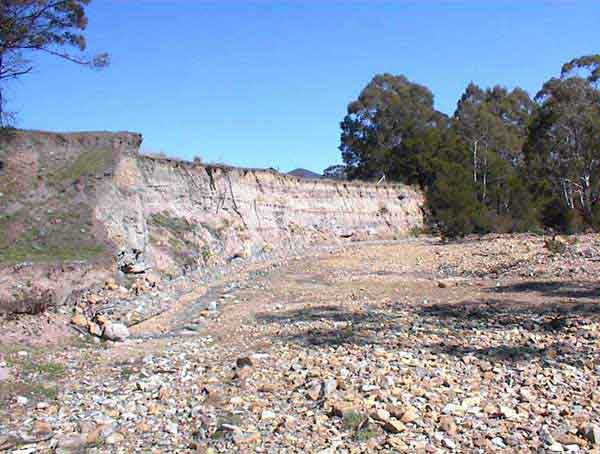Streambed & Streambank Erosion
By their very nature, rivers are the drains of the landscape, and are natural agents of erosion. But what is their natural or ?normal’ rate of erosion? And just how much has erosion been accelerated through poor management of drainage systems?
There has been a recent conceptual leap in understanding stream and river erosion within Australia. Previously, riverbank and streambank erosion – the removal of river banks by flowing water – was targeted as the major erosional problem to be addressed. However, we now understand that streambank erosion is an obvious symptom of a more fundamental problem within the drainage feature, the lowering of the streambed. This phenomenon may be much less obvious, but can be identified through the active sites, nick points and their resultant renewed instability of the streambanks.

Photo 1. An eroding bank in Tantulean Creek in NSW (photo courtesy of Upper Shoalhaven Landcare Council)
What is a Nick Point?
A nick point is an incised headcut within a stream bed, and indicates a sudden lowering of streambed level. This erosive feature is most obvious in coherent or semi-consolidated river bed material, usually as a small waterfall. In a gravel-bottomed stream, a nick point may be as subtle as a small incised channel within a riffle zone. In even finer gravels and sands, this feature is generally not recognisable. As the streambed erodes and lowers at this active headcut, the nick point migrates upstream, thereby creating progressive bed lowering of the entire stream. There can be many nick points active in a stream at any one time.

Photo 2. An example of a nick point in Durran Durra Creek, Upper Shoalhaven Catchment (photo courtesy of Upper Shoalhaven Landcare Council)
What is Stream Bed Lowering?
This is the result of migrating nick points. Where there is active erosion within the bed of a stream or river channel, the bed may be steadily lowered, creating relatively higher banks up onto the adjoining floodplain or terrace. The banks become increasingly steepened and unstable as this erosion is active at the toe of the slope. Streambed collapse and erosion occurs, and the channel commonly widens in conjunction with bed lowering. Other evidence of stream bed erosion can be the exhumation of roots of trees within the channel, or the exposure of foundations of man-made structures. If you have a good memory, or have historical reference levels to bridge or causeway foundations, these can generally provide the best indication to the longer-term changes in your stream.

Photo 3. Bombay Creek in NSW is a highly incised stream exacerbated by streambed erosion (photo courtesy of Upper Shoalhaven Landcare Council)
Rapid Buildup of Sediment in your Stream
Where there is erosion, sediment is mobilised and it may accumulate further downstream where flood energy conditions are not as severe. So if you observe siltation, or sediment buildup in a stream bed, it may indicate significant erosion is occurring upstream.
Potential Impacts on Coastal Waterways
Erosion from streambanks and gullys can generate as much as 90% of the sediment yield from a catchment [1,2]. The sediment is a major source of turbidity and particulate nutrients in some rivers and coastal waterways [1].
Further Insights
In the past, much of the work on streambank erosion directly addressed the symptom without perhaps fully questioning or understanding the cause. Today we think we understand processes a little better. It is now apparent that through stabilising or raising stream bed levels, bank erosion is also suppressed. This, in conjunction with appropriate revegetation of the banks, riparian zones and the various floodplain terraces in proximity to the channel, can only increase the resistance to erosional events in the future. The stabilising of the banks with vegetation also helps absorb the energy of the river during flood, and helps retain valuable topsoil.
With streambed lowering, and the related increased height of the banks and widening of the channel, floodwaters will not overbank as frequently. This may seem like progress to some in that there is less damage to fences and roads on the floodplains, and less standing water on valuable pasture, but it also means less silt deposition and rejuvenation on the floodplain, lower groundwater levels, loss of wetlands, and possible saline discharges from the base of gullys and streambanks. As usual, there is no free ride for long, and the sustainable use of floodplains comes with a responsibility and a ?price’.
Modifications to a river do have long-reaching consequences, but in the end, if the modifications are not compatible with the natural scale of energy-dissipating processes of the river, they will ultimately fail.
Because the condition of a river is a dynamic balance between all forces impinging on it, every modification made to it has an ensuing reaction. Rivers are not always in equilibrium with the dynamic balance where they should be, and there can be a considerable lag in time until the appropriate ?event’ provides the readjustment of levels or sediment supply or change of geometry in the channel.
In the bigger picture and longer timeframe, the river and its floods will always win out. But we also know that with appropriate measures and application of technology for erosion prevention, we can stall for time. We can help retain the riverine assets, as we now experience them, a little longer to maintain or improve the agricultural productivity, have satisfaction in conservation, and enjoy the recreational benefits. The unknown is for how many years?
- Hughes, A.O., Prosser, I.P., Stevenson, J., Scott, A., Lu, H., Gallant, J., and C. Moran. 2001. Gully erosion mapping for the National Land and Water Resources Audit. CSIRO Land and Water Canberra, Technical Report 26/01.
- Olley, J.M., Murray, A.S.. Mackenzie, D.M., Edwards, K. 1983. Identifying sediment sources in a gullied catchment using natural and anthropgenic radioactivity. Water Resources Research 29, 1037-1043.
Author
Bruce Radke, NSW Department of Land and Water Conservation.
« Back to Glossary Index

